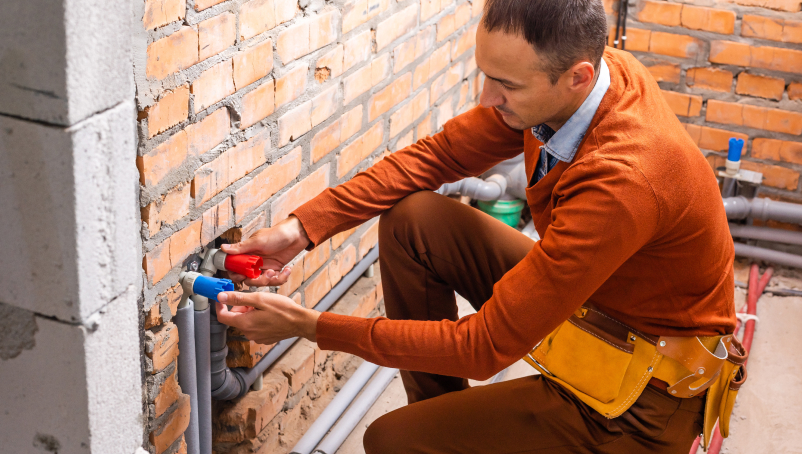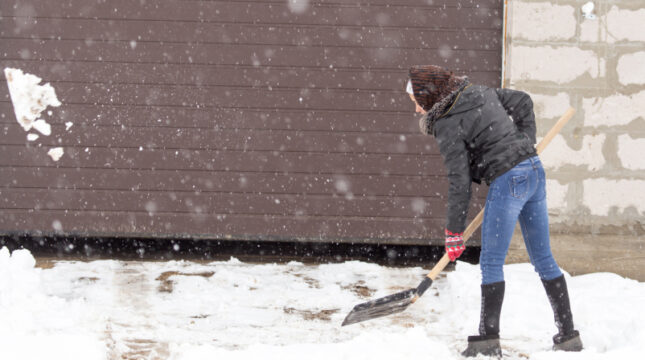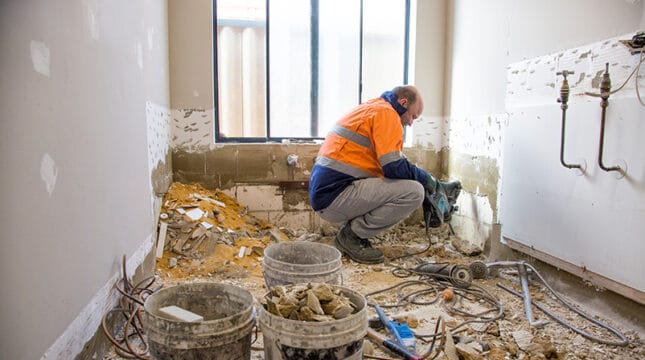5 signs of frozen pipes
Recognizing the early signs of frozen pipes can help you address the issue promptly and prevent further damage. Here are some common indicators:
- Reduced or no water flow. If you notice a decrease in water pressure or a complete lack of water from a faucet, it could be a sign of a frozen pipe.
- Frost or ice on pipes. Look for frost or ice forming on the outside of pipes, particularly those located near outside walls or in unheated areas.
- Unusual noises. Listen for strange sounds coming from your pipes, such as gurgling, banging or hissing. These noises can indicate that water is struggling to flow through frozen sections. They can also come from spots such as toilets or sinks.
- Discolored water. If you notice discolored water coming from your faucets, it could be a sign of a frozen pipe that has burst.
- Odd smells: A foul odor coming from your pipes can also be an indication of a frozen pipe that has ruptured.
By being aware of these signs and acting quickly, you can minimize the damage caused by frozen pipes and prevent costly repairs.
How to prevent your pipes from freezing
To avoid the hassle and expense of frozen pipes, it’s necessary to take preventive measures during cold weather. Here are some effective strategies:
- Insulate pipes. Install insulation around exposed pipes, especially those near exterior walls, attics and crawl spaces. Don’t forget your sprinkler system. This will help prevent heat loss and reduce the risk of freezing.
- Seal gaps and openings. Caulk or seal any gaps or openings around pipes to prevent cold air from entering.
- Keep the heat on. Maintain a consistent temperature inside your building with your thermostat, even when you’re away. A lower temperature can increase the risk of pipes freezing.
- Allow faucets to drip running water. During freezing weather, allow faucets to drip a trickle of water. This helps to keep the pipes flowing and prevents them from freezing.
- Winterize outdoor faucets. If you have outside faucets, disconnect and drain any garden hoses before the first freeze. Cover the hose bibs with a protective cover to prevent freezing.
- Consider a pipe wrap. If you live in a region with extremely cold winters, you may want to consider using a pipe wrap or heat tape to provide additional insulation.
By implementing these preventive measures, you can reduce the likelihood of frozen pipes.
DIY vs. professional installation:
Whether to insulate your pipes yourself or hire a professional depends on several factors:
- Accessibility. If pipes are easily accessible, DIY insulation might be feasible. However, if they are located in tight spaces or require specialized tools, it’s best to leave the job to a professional.
- Experience. Insulating pipes might be a manageable task if you have experience with plumbing or home improvement projects. However, it’s safer to consult a professional if you’re unsure of your abilities.
- Complexity: Complex systems or specialized materials may require professional help.
Implementing these preventive measures can significantly reduce the likelihood of frozen pipes and avoid the associated problems.
Insurance coverage for frozen pipes
Even with the best preventative measures, frozen pipes can burst, causing significant damage to your property and business operations. That’s where business insurance comes in.
Commercial Property insurance
Most commercial property insurance policies include coverage for frozen pipes that burst. This coverage typically includes financial help for repairing or replacing the damaged pipes and the cost of repairing any water damage caused by the burst.
Business income insurance
If a frozen pipe bursts and damages your business property, it may force you to close your doors temporarily while repairs are made. Commercial property coverage includes business income insurance, which can help compensate for lost income and expenses during this time.
Additional winter-related coverage
In addition to frozen pipes, commercial property insurance can also help cover other winter-related risks, such as:
- Snow damage. Damage to your property caused by heavy snowfall, such as roof collapse or damage to outdoor structures.
- Ice dams. Damage caused by ice dams, which can form on roofs and lead to water damage.
- Winter storms. Damage caused by winter storms, such as high winds, hail or sleet.
General Liability insurance
In addition to property damage, frozen pipes can also lead to liability issues. For example, if the burst pipe causes water damage to a neighboring business or property, you could be held liable for the damages.
General liability insurance can help protect you from such lawsuits by covering the cost of legal defense and any settlements or judgments. This type of insurance is essential for businesses of all sizes, as it helps safeguard your financial stability in case of an unforeseen incident.
Review your coverage
To ensure you have adequate coverage for frozen pipes and other winter-related events, it’s important to review your insurance policy. If you’re unsure about your coverage, consult with your insurance agent.
What to do if your pipes freeze
If you suspect your pipes are frozen, taking immediate action is important to prevent further damage. Here’s what you should do:
- Locate the frozen section. Use a thermometer to check the temperature of the pipes. If you find a frozen section, try to pinpoint its exact location. Turn on all faucets — if little or no water flows, you likely have a frozen pipe.
- Turn off the water supply. To prevent flooding in case the pipe bursts, shut off the water supply to the affected area. This is typically done by turning off the main shutoff valve.
- Open faucets. Open the faucets connected to the frozen pipe to relieve pressure and allow any remaining water to drain.
- Apply gentle heat. Gently apply heat to the frozen section to thaw frozen pipes. You can use a hairdryer to apply warm air, a heating pad, or warm towels wrapped around the pipe. Start from the faucet and work back toward the frozen section. Avoid using open flames (like a blowtorch) or extreme heat, as this can damage the pipe.
- Monitor the situation. Check the pipe regularly to see if it’s thawing. If it doesn’t thaw within a few hours, you may need to call a licensed plumber.
Remember, be patient; thawing a frozen pipe can take time. Avoid using excessive force or trying to force water through the frozen section. Also, avoid electrical hazards. Never use electrical heating devices near water. Ensure the area is dry before using a hairdryer or other electrical equipment.
What to do if a pipe bursts
If a pipe bursts, acting quickly to minimize water damage and prevent further complications is crucial. Here’s what you can do
- Turn off the water supply. Locate the main water shutoff valve and turn it off immediately to stop the flow of water. If you lease your property, notify the landlord or facility manager to help turn off the water.
- Shut off the electricity. If water has reached electrical outlets or appliances, turn off the main power supply to prevent electrical hazards.
- Remove valuables. Move furniture, electronics and other valuables away from the affected area to prevent water damage.
- Absorb water. Use towels, rags or commercial water-absorbent materials to soak up as much water as possible.
- Document damage. Take photos and videos of the water damage to support insurance claims.
- Contact a plumber. Call a professional plumber to assess the damage and make necessary repairs.
- Contact your insurer. Immediately notify your insurance company about the burst pipe. Provide them with the necessary information, such as the date and time of the incident, the location of the damage and any photos or videos you have taken.
- Ventilate the area. Open windows and doors to help dry the affected area and prevent mold growth.
By following these steps, you can mitigate the damage caused by a burst pipe and expedite the repair process.






